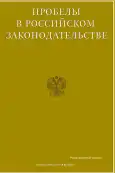Research of In-Prison Criminality in the Republic of Mordovia:An Introduction to the Problem
- Authors: Ageeva O.N.1, Anoshchenkova S.V.1, Petrikova S.V.1
-
Affiliations:
- National Research Ogarev Mordovia State University
- Issue: Vol 15, No 7 (2022)
- Pages: 202-209
- Section: Articles
- URL: https://journals.eco-vector.com/2072-3164/article/view/531812
- ID: 531812
Cite item
Abstract
Full Text
About the authors
Olga Nikolaevna Ageeva
National Research Ogarev Mordovia State University
Email: ageeva200981@mail.ru
Cand.Sci.(Law), Associate professor of the Criminal law, Criminalistics and Criminology Department Saransk, Russian Federation
Svetlana Vladislavovna Anoshchenkova
National Research Ogarev Mordovia State University
Email: anoshenkovas@list.ru
Cand.Sci.(Law), Associate professor of the Criminal law, Criminalistics and Criminology Department Saransk, Russian Federation
Svetlana Vasilievna Petrikova
National Research Ogarev Mordovia State University
Email: petrikova_sveta@mail.ru
Cand.Sci.(Law), Associate professor of the Criminal law, Criminalistics and Criminology Department Saransk, Russian Federation
References
- Aebi M.F., Linde, A. (2012). Conviction Statistics as an Indicator of Crime Trends in Europe from 1990 to 2006. European Journal on Criminal Policy and Research. 18 (1), 103-144.
- Aebi M.F., Linde, A., Delgrande, N. (2015). Is There a Relationship Between Imprisonment and Crime in Western Europe? European Journalon Criminal Policyand Research. 21(3), 425-446.
- Bakulin V.K. Control and supervision over penitentiary systems in France and the USA (2017). Astra Salvensis. 5 (10), 35-42.
- Starkov O.V. & Milyukov, S.F. (2001). Nakazanie: ugolovno-pravovoi i kriminopenologicheskii analis [Punishment: criminal law and kriminalistichesky analysis]. Sankt-Peterburg, 461.
- Gromov V.G. (2009). Kriminogennost' mest lisheniya svobody i ee neitralizatsiya [The criminality of the prison and its neutralization]: Avtoreferat dissertatsii doctora yuridicheskih nayk. Tambov, 50.
- Hohrin S.A. (2015). Penitentsiarnaya prestupnost' kak predmet pravovogo i kriminologicheskogo issledovaniya [Penitentiary crime as a subject of legal and criminological research]. Moskva, 173.
- Nikolaichenko V.V. (2006). Penitentsiarnye i postpenitentsiarnye prestupleniya: kriminalisti-cheskaya teoriay i praktika [Penitentiary and post-penitentiary crimes: criminalistic theory and practice]: Avtoreferat dissertatsii doctora yuridicheskih nayk. Saratov, 50.
- Antonyan Yu.M., Grishko, A.Ya. & Fil'chenko, A.P. (2009). Penitentsiarnaya kriminologiya [Penitentiary criminology]. Ryazan', 567.
- Avanesov G.A., Inshakov, S.M., Lebedev, S.Ya. & Eriashvili, N.D. (2006). Kriminologiya [Criminology]. Moskva, 496.
- Prozumentov L. & Filippova O. (2007). Prestupnost' v mestah lisheniya svobody: ponyatie, kriminologicheskaya harakteristika [Crime in prison: concept, criminological characteristics]. Ugolovnoe prаvo, (2), 125-128.
- Dunkel F. & Pruin, I. (2009). Summary analysis of the national to the questionnaire related to the treatment of juvenile offenders. European Rules for juvenile offenders subject to sanctions or measures. Strasburg, 216.
- Elliot C. & Quirin, F. (2000). Criminal Law. London, 94.
- King Roy D. (1995). Kathleen Mc Dermott. The state of our Prisons. New York, 357.
- Logan Ch.H. (1990). Private Prisons Cons and Pros. New York, Oxford Univesity Press.
- Bath M. (1988). StrafVollzug in beiden deutschen Staaten. Jura, 10, 404-410.
- Bemmann G. (1999). Zur Reform des Strafvollzugsgesetzes. ZfStrVo, 48, 202-206.
- Simes J.T. Place and Punishment: The Spatial Context of Mass Incarceration (2018). Journal of Quantitative Criminology. 34(2), 513-533.
- Prison population total, (2016). [Online] Available: http://www.prisonstudies.org/highest-to-lowest/prison-population-total?field_region_taxonomy_tid.
- Cavadino M., Dignan, J. Penal policy and political economy (2006). Criminology and Criminal Justice. 6 (4), 435-456.
Supplementary files








